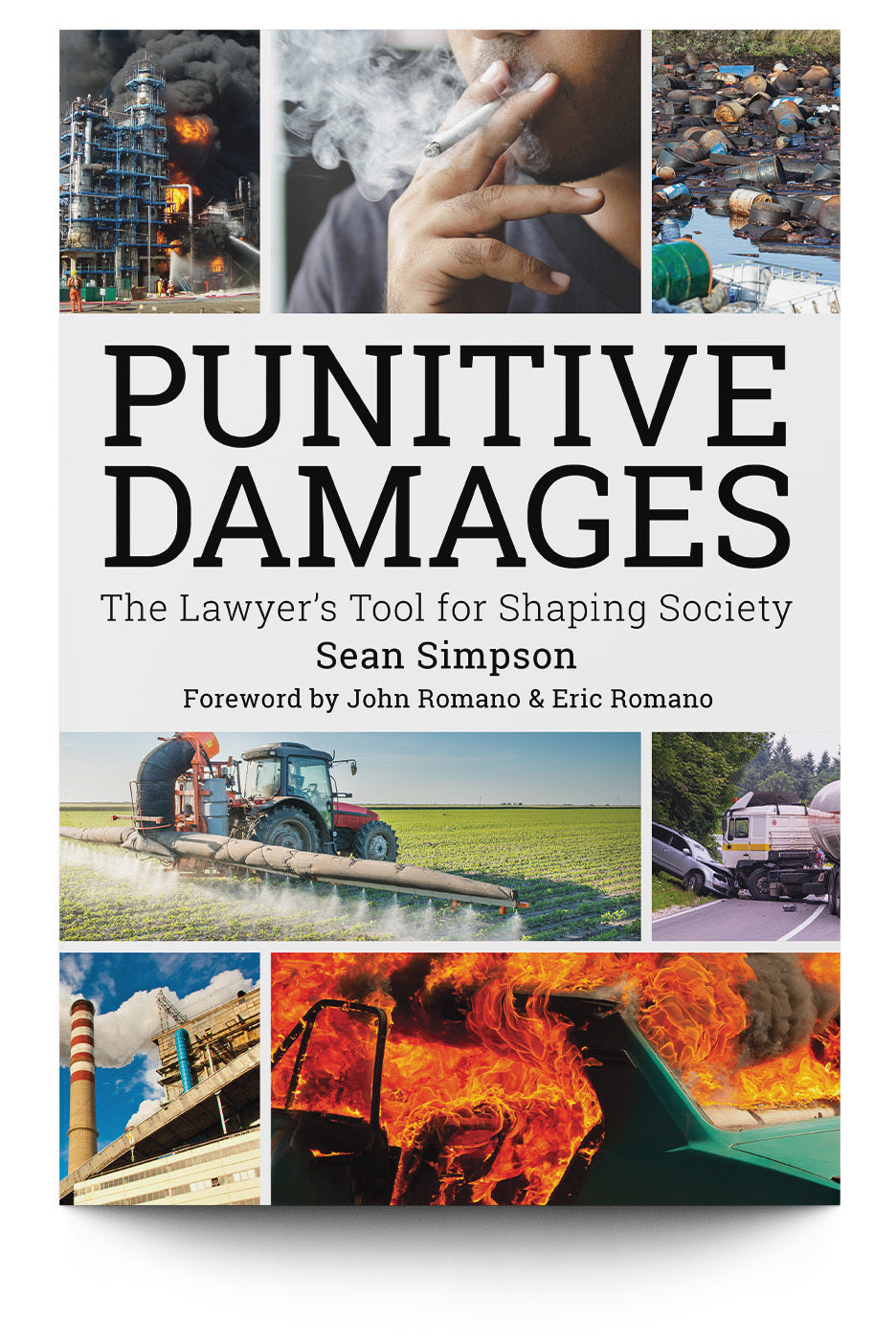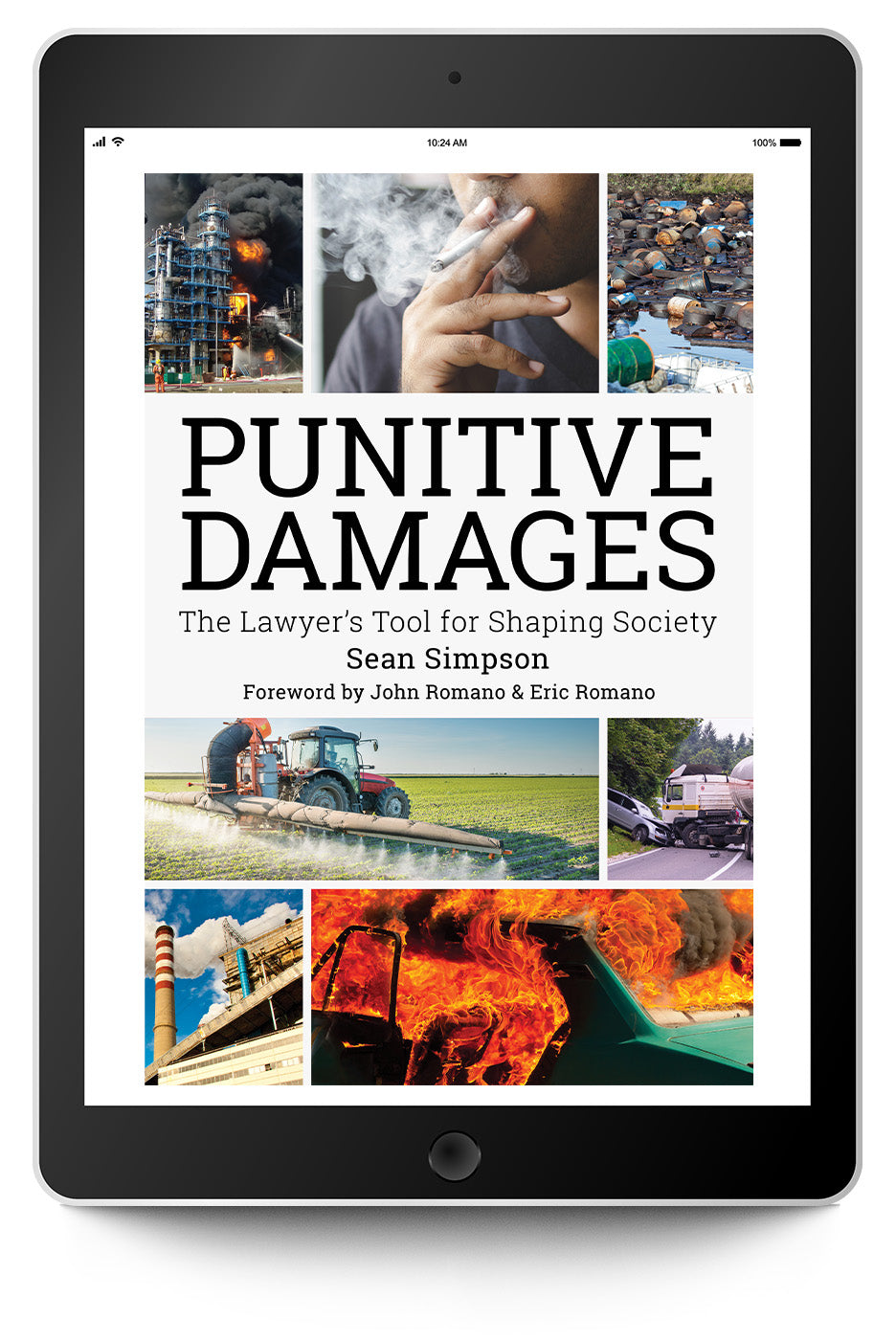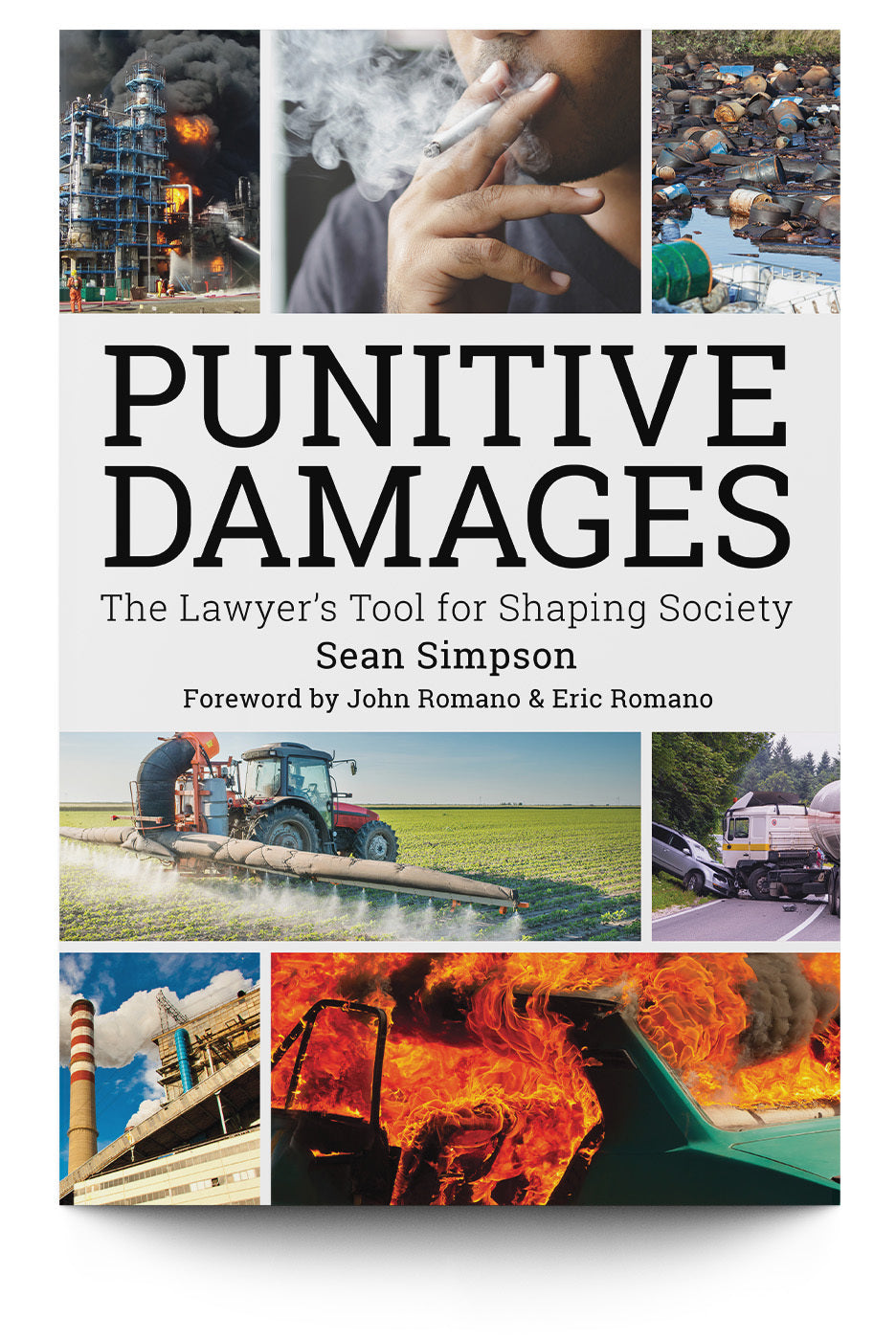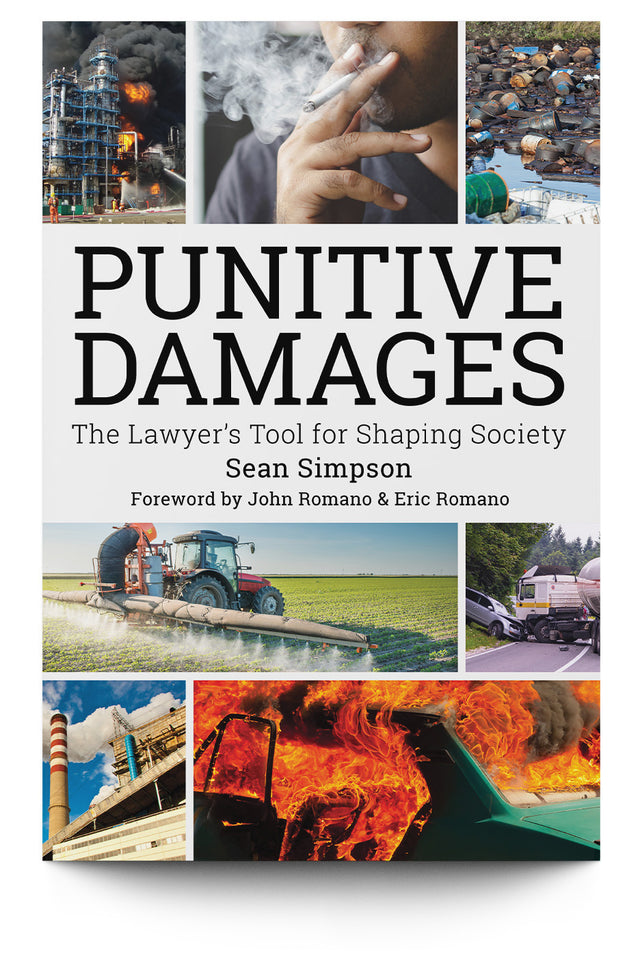Description
Description
“Punitive Damages is a long overdue masterpiece written by a real trial lawyer for the right reasons. If there were ever a ‘tool’ or ‘guide’ for lawyers to follow in their efforts towards achieving full justice through prosecuting punitive damages cases, this is it. After more than twenty-two years of practicing law, reading this book taught me how to be better and accomplish more for the humans I represent. The more lawyers (and hopefully judges) who read this book, the better our civil justice systems will be. Thank you Sean for teaching and inspiring us!”
—Nicholas Rowley, has won billions on behalf of injured clients, coauthor of Trial by Human and Damages Evolving
In Punitive Damages: The Lawyer's Tool for Shaping Society, trial lawyer and author Sean Simpson shows that punitive damages cases are more common than most lawyers think. Simpson draws lessons from numerous successful cases to provide lawyers with strategies and tools to identify and win punitive damages across a variety of different case types.
From a car crash where a client’s Nissan Sentra is rear ended by a commercial vehicle to cases involving dog bites, premises liability, insurance bad faith, elder abuse, business torts, civil rights, construction site injuries, employment discrimination, consumer fraud, and more, Simpson demonstrates that the potential for punitive damages can be found in many cases most lawyers wouldn’t initially consider.
Simpson tackles the common hurdles that cause many lawyers to avoid or overlook punitive damages in their cases and presents strategies to show how to successfully overcome them. Drawing from a range of case studies, Simpson provides lawyers with battle-tested approaches to increasing their client's case value and defending society from corporate wrongdoing. Simpson also offers strategies for keeping punitive damages awards intact post-verdict, and he discusses how to apply many of the techniques for developing and arguing punitive damages to get bigger verdicts in cases where punitive damages are not an option.
Punitive Damages covers the following and more:
- How to spot when you can apply punitive damages to your case
- Strategies for successfully countering tort reform myths
- How to know when you should (and should not) include punitive damages in your demand letters
- Which insurance policies are more likely to cover punitive damages–and which are not
- Techniques and examples that will help you push back against defense stonewalling and take your discovery to the next level
- An analysis of past depositions that show steps you can take to lock in a punitive damages claim
- How to use jury instructions and state laws to guide your investigation
- How to make the best use of jury selection in a case where you plan to seek punitive damages
- Strategies for opening statement, including how to avoid issues with the court
- How to put the defendant on trial right out of the gate
- Case studies showing how several successful punitive damages verdicts were built
- Core concepts in punitive damages jury instructions
- How to avoid common pitfalls
- Strategies for closing argument
- Specific techniques designed to help keep your punitive damages verdict intact
- Tactics for increasing compensatory damages
In Punitive Damages, Simpson arms lawyers to do more than “joust at windmills” or seek “big money,” instead he offers a path to making things better for injured clients, and making society a better place.
Don’t become complacent with a status quo that lets corporate wrongdoing run rampant over clients’ lives. Punitive Damages shows ways attorneys can make a difference and work side by side with their fellow plaintiffs’ lawyers to keep corruption in check.
Your eBooks are now accessible from your Trial Guides account! Click here for step by step instructions.
Do you want the eBook and print book? After you complete your purchase of the print book you will receive a coupon code via email to purchase the eBook for $20.
Author
Author
Details
Details
Paperback: 298 pages; 1st Edition (2024); ISBN: 978-1-951962-65-4
Publisher: Trial Guides LLC
Table of Contents
Table of Contents
Foreword
Acknowledgments
Introduction
- The Basic Steps
- Spotting Punitive Damage Cases
- Countering the Tort Reform Myth
- Demands, Settlements, and Mediations
- Dig Deeper for Facts Using Written Discovery
- Painstaking Depositions of Quasi-Criminal Deponents
- Getting From the Culprit to the Company
- You Only Get One Jury
- Opening Statement
- Reverse-Engineering Your Trial
- Closing Time! First Phase
- Closing Time! Second Phase
- Resisting Reduction Post Trial
Conclusion
Appendix
About the Author
What Legal Leaders Are Saying
— Michael Alder, trial lawyer, adjunct law professor, youngest winner of Los Angeles trial lawyer of the year, and has obtained over $3 billion in verdicts and settlementsSean is the real deal. He clearly is battle tested and this book gives you the benefit of so much amazing experience and advice. I loved it.
— Timothy Whiting, nationally board certified lawyer in truck accident law, executive board member and past chair of the Academy of Truck Accident Attorneys (ATAA) and executive board member of the AAJ Truck Litigation GroupI have found that punitive damages are the one thing that truly holds large corporate defendants accountable. They are the difference maker between a company sweeping their egregious conduct under the rug and having to own up to it in front of the jury. Every plaintiff's lawyer handling serious cases needs to read this book to maximize their skill set for framing the case and proving punitive damages in trial. Because of Sean’s inspiration and insight, I now look closely for punitive damages in every one of my cases and look forward to proving them up more methodically using the principles he describes in great detail in this book.
— Theresa Bowen-Hatch, trial lawyer and coauthor of Trial By WomanEverything you need to know—and everything you didn’t even know you needed to know—about punitive damages in one place! Excellent insights, strategies, and real-world examples of how to master this important damages claim.
— Susan K. Roberts, Senior Litigation Paralegal at Perkins Coie, Portland, OregonAs a senior trial paralegal, I found the chapters related to deeper discovery and meticulous depositions very helpful and inspiring. While the book may be mainly for trial lawyers, I highly recommend it be shared with any paralegals who want to hone their discovery skills. Regardless of your role on the trial team, the chapter on rethinking inside the box will remind you why you chose this profession. I have known Sean since the days of youth swimming, and this book shares much of his life-long passion for making the world a better place. And by reading it, you will pick up many nuggets and hopefully have your passions inspired!
— Prof. Richard Conviser, founder and CEO BAR/BRI Bar Review, professor emeritus at Chicago-Kent College of Law and Emory University School of LawThis book is a valuable tool for young trial lawyers representing injury victims, or any plaintiff’s trial lawyer who wishes to gain more insight on pursuing punitive damages. The author’s insight and the publisher’s layout walk you through every phase of the punitive damages process.
— Jayme Spradlin, past chair of the New Lawyers Division of Consumer Attorneys of California, recipient of the Consumer Attorneys of San Diego Outstanding Trial Attorney Award, and CAOC Street Fighter Award FinalistThanks to the vast collection of wisdom, creativity, and actual experiences Sean lays out in this guide, I have had my eyes opened to the untapped potential of punitive damages in a wide variety of cases. The chapter on using punitive damages in 'Demands, Settlements, and Mediations' is worth the price of the book alone!
— Sarah Havens, 2025 Consumer Attorneys of San Diego President, NITA Faculty Trial Skills Teacher, 2015 Trial Lawyer’s College Graduate, Super Lawyer, ranked Top 100 Civil Plaintiff by The National Trial LawyersFinally, someone has put together a comprehensive guide addressing all aspects of punitive damages from a trial lawyer’s perspective. The author has spared nothing as he shares his insight learned from real cases and real trials. [It is] so handy to have separate chapters for each phase of trial and the pre-trial litigation process. I really appreciate how each chapter can be read separately and provides a full tutorial on how to address any given step in the process. This book is like having a personal mentor prepare you for each phase! I feel more motivated and confident about pursuing punitive damages, and I think most readers will gain the same benefit—I highly recommend giving it a read!
— Julie K. Parker, trial Lawyer, San Diego; Recipient of Outstanding Trial Lawyer Awards from Consumer Attorneys of San Diego 2009, 2014.Finally, a clear, comprehensive guide for navigating punitive damages! Sean’s passion for curbing misbehavior is apparent throughout the book as he shares insights and nuggets he has gathered over many years. I remember Sean sharing tips with me several years ago outside the courtroom when I was battling through phase two in a large punitive damages case, and now Sean shares the same intel from his heart and soul in a handy book! This is a must-read for anyone handling punitive damages cases, and the discovery techniques will help maximize your compensatory damages too.
— Brian Panish, Managing Partner at Panish|Shea|Ravipudi, past president of the Inner Circle of Advocates, has nine verdicts over 50 million, forty over 10 million, and one product liability verdict against General Motors for $4.9 billion, which included $4.8 billion in punitive damagesThis book is a step-by-step guide for handling punitive damage cases. Any lawyer who has not tried a punitive damage case to verdict should read this book—even those who try punitive damage cases. This book is a great refresher and provides some new twists! Good read, specific examples, great addition to the Trial Guides library!
— David Ball, PhD, trial consultant and author of David Ball on DamagesFinally! Over my four jury consulting decades, one of my pet peeves has been the reluctance of so many attorneys to seek punitive damages. ‘No, that won’t work in this case’ is the too-frequent refrain—when in fact it would work if the lawyer knew more about how. The money left on the table, the case-killing contrib verdicts that could have been winners, the wasted improvements to public safety—all victims of attorney reluctance to use our most powerful civil deterrent. Sickening. But now, finally and long overdue, Sean Simpson’s Punitive Damages lays out the nuts and bolts of successful punitive damages pursuits and why they are worth pursuing even when the defendant’s insurance won’t cover it. He takes us from the basics all the way through far more than what you think you know, so you’ll see how much more often it can be done than you think—and how to do it. Most valuable and inspiring is that he motivates you to do it. Give this book a read, give its methods a try; they will likely change, among other things, the trajectory of your career. My sole criticism: Mr. Simpson waited too damn long to give us this treasure of a guide and workbook.
— David S. Casey, past president of AAJ and CAOCHere is a well written book that gives you the tools to be a more creative trial lawyer and increase the value of your cases. Sean's talent, passion, and analytical skills, based on decades of trying cases, comes through clearly. His book is a gift to those who enter the courtroom arena. It will be required reading at our firm.
— Craig R. McClellan, member of the Inner Circle of Advocates, has over 150 verdicts and settlements in excess of $1 million each, Fellow of American College of Trial Lawyers, San Diego Trial Lawyer and Lawdragon Hall of Fame inducteeSean’s book on punitive damages is a goldmine for all plaintiff lawyers. Lawyers with punitive damage cases will be exposed to new concepts, ideas, and approaches, with specific examples of evidence to look for, strategies to use, and arguments to make. For lawyers without punitive damage cases, you won’t be without them for long after you read this.






